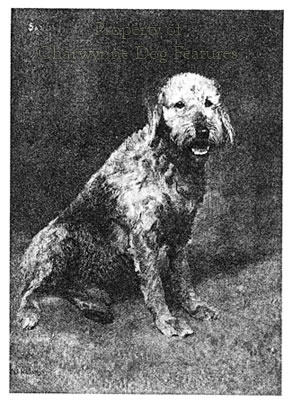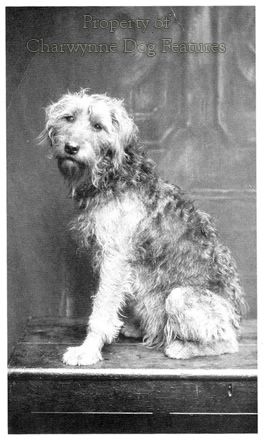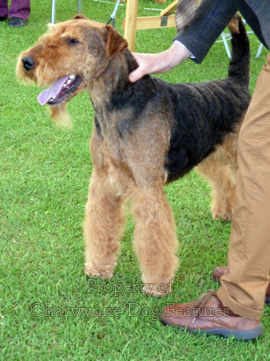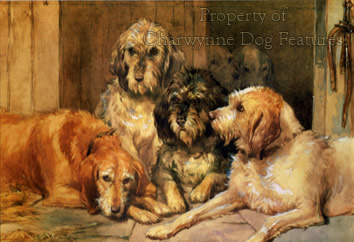938 THE AIREDALE - YORKSHIRE GRIFFON OR LANCASHIRE'S OTTERHOUND
The Airedale - Yorkshire Griffon or Lancashire's Otterhound?
by David Hancock
 My interest in this once-popular breed was aroused when, as a young teenaged 'kennel-boy' working for my local vet, I went with him to visit Molly Harbut's world-famous 'Bengal' kennel of superlative Airedales, at Bathampton, near Bath. Her dogs won prizes all over the world but even at that young age I couldn't see them as terriers, i.e. dogs that go to earth. For me, it is an enormous pity that this breed of Airedale ever became dubbed a terrier. That word should be reserved for dogs that go to ground. In France the Airedale would have been called a griffon, a rough-coated hunting dog, a hound if anything. This breed should not be regarded as a terrier and should not be judged by those more familiar with the breeds developed to go to ground. But above all, it should be regarded as a sporting dog, with the anatomy to allow it to function in the hunting field. It is of course a remarkably versatile breed, able to undertake manifold tasks.
My interest in this once-popular breed was aroused when, as a young teenaged 'kennel-boy' working for my local vet, I went with him to visit Molly Harbut's world-famous 'Bengal' kennel of superlative Airedales, at Bathampton, near Bath. Her dogs won prizes all over the world but even at that young age I couldn't see them as terriers, i.e. dogs that go to earth. For me, it is an enormous pity that this breed of Airedale ever became dubbed a terrier. That word should be reserved for dogs that go to ground. In France the Airedale would have been called a griffon, a rough-coated hunting dog, a hound if anything. This breed should not be regarded as a terrier and should not be judged by those more familiar with the breeds developed to go to ground. But above all, it should be regarded as a sporting dog, with the anatomy to allow it to function in the hunting field. It is of course a remarkably versatile breed, able to undertake manifold tasks.
My interest in them also came from Colonel Richardson's use of them as service-dogs over a century ago. Airedales were used extensively in the Russo-Japanese and the Great Wars as sentry-dogs, messengers and ambulance-dogs, emerging as the best all-round war dog breed. Police forces from as far afield as American cities and Paris elected to use them too. Colonel Richardson, who was Commandant of the British War Dog School in 1916, recorded: "I have owned and trained at one time or other, nearly every kind of dog suitable for guarding work...but, as a result of all my work of years, it is my considered judgement, that for all-round watching and guarding work, the most reliable dog in size and character is the Airedale Terrier." In 1920, the Airedale was the most popular breed in the USA. Over 5,000 were registered here in each of the years 1924/25/26. Nowadays only a fifth of that number is registered each year. But US popularity and service dog use apart, this breed is essentially a sporting breed.
As Frank Townend Barton wrote, in his The Kennel Encyclopaedia of 1930: "The Airedale terrier cannot claim much in the way of ancient origin, as it was not until about 1853 that Wilfred Holmes crossed the local terriers...with the otterhounds, in order to produce a larger and gamer type". I suspect that Yorkshire sportsmen blended the blood of the old broken-coated black and tan working terrier with that of the northern breed of black and tan wire-haired hound, sometimes called the Lancashire Otterhound. The Otterhound, as we know it, did not emerge as a breed until after 1880. The classic Otterhound coat colours include black and tan, blue and tan, liver and tan or liver, grizzle and tan. The Airedale has to have a black or grizzle body saddle with tan beneath. I have seen quite a number of Otterhounds with a distinct 'Airedale' look to them; the Airedale breed originally excelled in water. 
There has long been disagreement about size and coat colour in the breed, at a time when anatomical soundness has been less common. Which would you prefer, a sound strapping dog over the breed's weight limit or an officially acceptable unsound dog within the breed's stipulated weight? Why be prejudiced against really good dogs on weight and colour alone? But let two authorities on breeds of dog of eighty years ago have the last word on colour in this breed. Writing on early Airedales, Walter S Glynn wrote: "A real black and tan coat was not to be seen among them; all were possessed of the blue-grey colour, some darker than others..." Theo Marples wrote: "In the matter of colour, black-and-tan or grizzle-and-tan is the correct colour, but, as in the horse, a good Airedale can hardly be a bad colour." Perhaps now is the time to concentrate not on colour but on coat texture, in good Airedales. This is an under-rated, unfashionable, under-used breed truly worthy of promotion. .jpg)
In 'Hounds and Dogs' of 1932, a volume of the Lonsdale Library, Capt. Banes Condy wrote: "No book dealing with Sporting Dogs would be complete without mention of the Airedale Terrier..." going on to state he had exported them to India to hunt jackal in pack "where his good nose, hardihood, lasting capabilities and strength make him invaluable." Banes Condy emphasized one point: "People, both breeders and novices, have somehow or another got it into their heads that an Airedale must be a rich black and tan in colour. This is erroneous..." In the world of kennel clubs all over the world today black and tan is the favoured breed colour; in the United States some breeders favour all-black and all-red Airedales, no doubt shocking the breed-purists or coat-colour devotees.
As a sporting dog, the Airedale has long been valued, mainly overseas. In his 'Hunting Dogs' of 1909, the American sportsman-writer, Oliver Hartley recorded: "I have found out that the pure Airedale Terrier and the hound make the very best dogs for coon, lynx, mink, etc. Get a good Airedale and a good hound and you will have a pair of hounds hard to beat..." He went on to state that Airedales were 'great water dogs and very hard workers and easily trained to hunt any kind of game. They are full of grit and fear nothing...' He further sang the breed's praises 'in hunting and dispatching coyotes, coons, badger and bay-lynx (i.e. reddish-brown lynx), any one of which is capable of putting up a good fight. Also he is a hunter, retriever, trailer of coon, 'possum, bear, wildcat, mink, coyote, deer, lynx, fox or small game.' That is some tribute from a highly-experienced hunter, operating in difficult terrain.
I am very disappointed by the Airedales I see in show rings, both here and at World Dog Shows. Their movement is restricted, especially by upright shoulders; the coat texture is woolly rather than hard, dense and wiry; the expression in the eyes is lifeless and compliant; the rear action lacks drive and the forehand is too 'Pedigree Fox Terrier' to be sound. I cannot understand the desire for a narrow front in a sporting dog that was never expected to 'go to ground'. Perhaps this is a penalty for the terrier classification. The strange pursuit too of a short back, even in the Breed Standard, is puzzling. Why does a hunting dog, around two feet at the withers, need a short back? I wonder if this desired requirement wasn't just copied from other terrier standards when the Airedale first came, later than some, as a breed, on to the dog scene.
One Airedale critique of a decade or so ago read: "It makes no sense for a breeder to keep a puppy that shows an incongruity between the size of upper arm and shoulder blade...every breeder knows that a well-laid back shoulder demands an upper arm of the same length." The SWKA Airedale judge of 1997 wrote: "Movement in Airedales has deteriorated to the extent that I cannot honestly say that any one of the ones I judged could be classed as having excellent movement. The best I would rate as passable and the worst as appalling." The 1998 Crufts Airedale judge wrote: "Movement is still a problem...One of the reasons is the absence of really laid back shoulders." The 1999 Crufts Airedale judge wrote: "Movement, as always, is not as it should be." The following year at Crufts, a different judge reported: "Movement is shocking...come on you Airedale breeders...own up to the faults in your dogs..." Two years later, at the Midland Counties Airedale Club November show, the judge wrote: "The modern Airedale lacks the drive and rhythm of its forerunners moving and it appears that little is happening to attempt a remedy to offset such a situation. This may be in part due to there being too few who can remember true Airedale movement..." This makes a sad judgement on Airedale breeders but without due attention it can happen in any breed; it's a warning to all.
Nearly fifty years ago, the well-known Airedale judge Fred Cross was questioned on why he had awarded the challenge certificate to a bitch with what some fanciers considered to be a rather large head. He responded, admirably for me, with the words "She doesn't need to walk with her head!" Sound movement should always be a top priority in judging dogs. Fred Cross would not be pleased to see the high number of present-day Airedales which either step short in front or reach forward with a Hackney action, both caused by faulty front assemblies. But in so many breeds nowadays across the various groups, upright shoulders and short upper arms are giving them uncharacteristic let alone flawed movement. You don't see many Foxhounds with these faults, they have to function. 
It is comforting to learn of the work of the Airedale Club of America in promoting the field use of the breed. This club, twenty years ago, formed a hunting/working committee to help promote and maintain the Airedale's innate hunting ability. In 1994, hunting tests and titles were conceived to test the breed in three areas. Firstly, the upland bird test requires the dog to find and flush two planted birds, retrieve a shot bird on land and complete one short water retrieve. Qualifying dogs receive the junior hunter-flushing certificate. In time, dogs can go on to earn senior titles by displaying greater proficiency in the retrieving work. Secondly, the hunting dog retrieving test involves the retrieve of two chukars on land and two ducks on water, to earn in turn the junior, senior and master hunter-retriever certificate. Thirdly, the hunting dog fur test requires a dog to follow a pre-laid track of raccoon scent and to bark or bay its quarry when found, again to earn the step-by-step graduation titles.
An Airedale qualifying in all three basic tests earns the title of junior hunter versatile or JHV, with senior and master titles also on offer. A few years ago, Moraine Prime Minister, became the first show champion Airedale to earn the master hunter title in all three areas of expertise. It is so pleasing to learn of such a feat, the Airedale is a sporting breed. I bet that Moraine Prime Minister doesn't have lifeless eyes! All dogs love to be useful. Every sporting breed needs a spiritual outlet. Shame on the British breed clubs for not giving their Airedales such stimulating activities. The 'Yorkshire Griffon' would look very different if it had to prove itself in the field. I suspect too that the owner-dog bond would be enhanced as well. This is a sporting breed being neglected.
An early fancier, E Bairstow of Bradford, wrote around 1890: "In all my experience, I never came across any person who ever had an Airedale terrier over twelve months who would utter one word of disparagement against him...This breed owes its origin to the working or middle class inhabitants of Airedale and surrounding districts; take Bradford as the centre, and say about a 15 mile radius..." Do the good people who live in that catchment area now realise what their ancestors bequeathed to the sporting dog fraternity all over the world? Our precious sporting heritage slips away from us every year. Should not our Yorkshire-based breed devotees strive to celebrate such a local achievement? The towns of Rottweil and Leonberg would not miss such a chance! We promote their German dogs with greater enthusiasm than we do our English Airedale, alias the Yorkshire Griffon, maybe too our Lancashire Otterhound. Perhaps it's time we stopped breeding Airedales to be so 'terrier-like'!